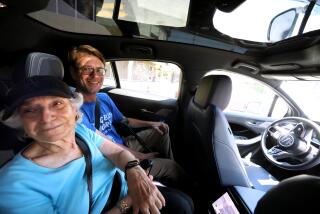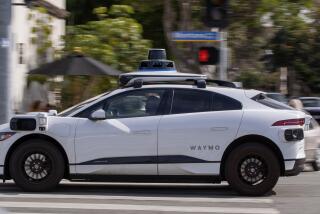OnStar From GM: It’s Only Human
I must admit that I’m seriously challenged when it comes to navigating my way along freeways and surface streets, even parking garages. I have absolutely no internal compass. I was absent the day directional brain cells were handed out.
So I recently jumped at the chance to test-drive a 2000 Saab 9-3 convertible with the General Motors OnStar navigation system. I figured I could leave all the navigating up to my personal OnStar “advisor,” whom I could summon with the press of a button.
OnStar’s in-vehicle safety, security and information service combines Global Positioning System satellite technology and wireless communication to link the driver and vehicle with a 24-hour command center in Michigan (more on issues of geography later).
Since its introduction in 1996, OnStar has grown to a subscriber base of 250,000 in the U.S. and Canada, says Geri Lama, a spokeswoman for the service. The system logs 12,000 to 15,000 calls a day, about 5% involving emergencies.
OnStar is available on 29 models in GM’s extended family, from Cadillac and its other American makes to Saab of Sweden and, eventually, Honda’s Acura line.
“We predict the system will be available on 1 million vehicles by the end of this year . . . and available on 4 million vehicles by 2003,” Lama said.
With OnStar, there are no computer screens with maps or directories to look at, no computerized voice recording.
Instead, the system puts you in direct cellular contact with a living, breathing human being who can, for example, send emergency assistance your way, track your vehicle if it has been stolen, give you directions, remotely unlock your door and perform remote vehicle diagnostics if you’re having car trouble.
In addition, OnStar operators (“advisors,” to use GM’s term) can find the nearest hotel, make dinner reservations at your favorite restaurant, even get you theater tickets.
If an air bag deploys in the vehicle, the system automatically notifies the OnStar command center. An advisor will immediately call in response. If there is no answer or if the advisor otherwise determines that you need help, he or she will notify law enforcement to dispatch someone to your satellite-tracked location.
Dave, my first friendly OnStar guy back at the command center in Troy, Mich., outside Detroit, steered me impressively to my first few destinations.
OnStar routed me perfectly to restaurants, ATMs and even the closest Nordstrom when I was in Redondo Beach. I saw how advisors could remotely unlock my car if I lost my keys and remotely flash my lights and honk the horn to help me locate my car in a crowded parking garage or parking lot. I was ecstatic.
Geez, I thought. I wish I would have had this the time I tried to take my dad to a football game at the Rose Bowl. Because of my poor sense of direction, it was a disaster. I took the wrong freeway and we ended up in Corona.
Despite my early success with OnStar, the more I tooled around Orange County and Los Angeles in the Saab, the more I began to encounter problems with the navigation system.
If you’ve seen the flashy new Batman television ads for the service, you’ve seen the caped crusader successfully reach his Gotham City destinations in his OnStar-equipped Batmobile.
Good thing Batman isn’t in Southern California trying to get to the city of Industry, or he’d have a rough time finding it.
On a trek from Los Alamitos in Orange County to my son’s tennis tournament at the Sheraton Resort Hotel in Industry, I buzzed OnStar to get the best directions.
Initially, my advisor said she couldn’t locate Industry or the hotel’s address on any maps at her disposal. She asked if it was a small town or if it was a new city that wouldn’t yet be on the map.
I explained that Industry is an established city, and I even gave her a hint by telling her that I was already going north on the 605 Freeway and that I needed to connect with another freeway.
Yet she insisted I needed to exit the freeway immediately and take surface streets. The route she conveyed was way off the mark. Her directions would have taken us not to Industry but to a Sheraton in Cerritos, about 30 minutes from our destination.
Frustrated, I signed off from the system. A few minutes later, she called back with the correct directions.
After a few experiences like that, I was reluctant to follow OnStar’s directions blindly. Fortunately, I was able to second-guess the advisor because I was familiar with the area. But imagine if you were a tourist. You’re counting on the directions to be reliable.
My OnStar test drive taught me a couple of important things:
First, the navigation system is only as reliable as its computerized map system and site lists of banks, gas stations, amusement centers, stores and the like. Lama says GM updates its database quarterly. But if OnStar’s resources aren’t up to date or are incorrect, you’d better have an old-fashioned map handy.
Lama acknowledges that “keeping up with openings and closings and whatnot is a challenge for us--we are dependent on our maps.”
At present, nearly all of OnStar’s advisors work out of the command center outside Detroit, a fact that seems certain to limit the amount of knowledge they would have on regions outside the Midwest.
A new center is open on a limited basis in Charlotte, N.C., Lama said, and “we’re scouting out another location out West.”
“We think people with local or regional knowledge can give you better service than someone in Detroit can talk about Los Angeles,” she said.
Second, when it works, OnStar gives you a great sense of security. True, some drivers may view the service’s tracking ability as an unwelcome example of Big Brother. Nevertheless, I for one find it comforting to know that emergency help is just the press of a button away and that your car is being carefully tracked. I believe this kind of service should be standard equipment in every vehicle on the road.
The caveat is that the system works only if you’re in a cellular-phone service area. When you’re out of range, you’re back on your own.
“People who’ve called for roadside assistance say the response is very good as long as they are in a cell,” said George Peterson, president of AutoPacific Inc., an industry research and consulting firm in Tustin. “If you’re out in the middle of the Mojave Desert and you can’t get a cell-phone signal, then you’ve got nothing.”
For some users who have tried OnStar, the problems are more basic than geography.
Indeed, Peterson said, “some people who have used the system say they don’t really like talking to a human being for that period of time. They find it uncomfortable. They don’t want to have a long conversation with someone.”
And California offers an additional challenge: Spanish-based place names.
Users surveyed by AutoPacific have complained that “a high percentage of the OnStar operators can’t pronounce Spanish names or words,” Peterson said.
The analyst’s own experiences with OnStar have been frustrating.
When he tested OnStar by seeking directions to his home in an unincorporated area of Orange County, Peterson was told that, based on the mapping information in the database, “there was no way to get to our house.”
“The guy got us to the other side of the hill from where we live and says, ‘If you look up you should be able to see your house from there,’ ” Peterson recalled.
Of course, other in-vehicle navigation systems also have the potential for error. Peterson said he encountered similar problems with a screen-based on-board mapping system that advised taking mostly surface streets from Orange County to a Beverly Hills destination.
Until recently, OnStar was a dealership-installed option costing $695 to $895. OnStar’s three-button system is now standard equipment or part of an options package, says Lama, who declined to say how much the factory-installed system adds to a vehicle’s sticker price. (The loaded Saab I test-drove had a sticker price of about $43,000, said Peter Ngo, sales manager at Saab of Santa Monica.)
Users pay $199 a year for the basic safety and security system. Premium service--which adds navigation and concierge assistance--runs $399.
We put OnStar through one final test: Though GM brags about being able to obtain theater tickets, my advisor couldn’t locate a major movie complex. When I asked for the movie theater nearest to my location near Long Beach, the advisor insisted the closest one was in Whittier. The database completely overlooked a 26-theater complex within three miles of my location.
“We should have had that,” Lama said. “We didn’t.”
*
Jeanne Wright cannot answer mail personally but responds in this column to automotive questions of general interest. Write to Your Wheels, Business Section, Los Angeles Times, 202 W. 1st St., Los Angeles, CA 90012. E-mail: [email protected].






